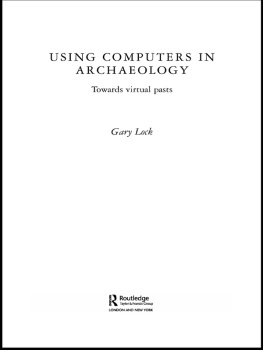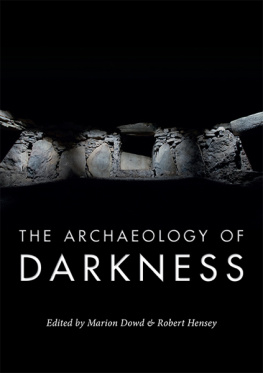
CAVES AND RITUAL IN MEDIEVAL EUROPE, AD 5001500
Edited by
Knut Andreas Bergsvik and Marion Dowd

Published in the United Kingdom in 2018 by
OXBOW BOOKS
The Old Music Hall, 106108 Cowley Road, Oxford OX4 1JE
and in the United States by
OXBOW BOOKS
1950 Lawrence Road, Havertown, PA 19083
Oxbow Books and the individual contributors 2018
Hardback Edition: ISBN 978-1-78570-832-9
Digital Edition: ISBN 978-1-78570-833-6 (epub)
Mobi Edition: ISBN 978-1-78570-834-3 (mobi)
A CIP record for this book is available from the British Library
Library of Congress Control Number: 2017956891
All rights reserved. No part of this book may be reproduced or transmitted in any form or by any means, electronic or mechanical including photocopying, recording or by any information storage and retrieval system, without permission from the publisher in writing.
For a complete list of Oxbow titles, please contact:
UNITED KINGDOM
Oxbow Books
Telephone (01865) 241249, Fax (01865) 794449
Email:
www.oxbowbooks.com
UNITED STATES OF AMERICA
Oxbow Books
Telephone (800) 791-9354, Fax (610) 853-9146
Email:
www.casemateacademic.com/oxbow
Oxbow Books is part of the Casemate Group
Front cover, top: Predjama cave and castle, Slovenia (photo: S. Sykora); bottom: a Smi grave in a cave on the island of Spildra, Norway
(photo: A. Svestad).
Back cover: Brackens Cave on the coast of Rathlin Island, Co. Antrim, Ireland (photo: A. McInroy).
Preface
It is no small irony that this book has been edited by two prehistorians. In the course of our separate researches into the prehistoric archaeology of caves and rockshelters in Norway and Ireland respectively, we became aware that these natural landscape features contained rich medieval assemblages that represented a wide range of human activities. This data, with few exceptions, had been almost entirely neglected by medieval historians and archaeologists. We soon discovered that the situation was typical of most other countries in Europe. This realisation became the impetus for a session at the 19th Annual Meeting of the European Association of Archaeologists (EAA) in Pilsen, in the Czech Republic, in September 2013 titled, The use and perception of caves and rockshelters in early medieval Europe (AD 4001200).
As we had hoped, the session attracted much interest and enthusiasm. A wide range of questions were raised that reflected the poorly understood role of caves in medieval Europe up to that point. For instance, how were caves and rockshelters used and perceived by people during these centuries? Did they serve different functions across different parts of Europe? Were there differences between how local populations versus immigrants engaged with caves? To what extent did local geology influence usage? Were artificial rock-cut caverns used in similar ways to natural caves, and did deep caves function differently to rockshelters? What can be said of those who utilised caves in terms of social status, ethnicity, or gender? Was there a correlation between cave morphology or location and specific ritual or secular activities? Were there differences between Christian and Muslim cave use? How did the conversion to Christianity affect caves that were ritually significant in earlier pagan times? Were caves still used for burial after the conversion to Christianity? How did popular religious practises in caves differ from formal official Christian activities? How did cave churches relate to wider Christian landscapes? What emotions did caves evoke? Methodological questions were also raised: How can we distinguish, archeologically, between ritual and secular functions of caves? How do we deal with legacy data from antiquarian cave investigations? What is the relationship between medieval cave archaeology and how these places are referred to in medieval texts? How can early literary sources be better integrated with the archaeological data? How should folkloristic accounts of caves be used, if at all? Can placenames be useful in understanding medieval cave archaeology?
The discussion that emerged from the 2013 EAA session in Pilsen resulted in a decision to bring together a unique publication on medieval uses and perceptions of caves and rockshelters. The religious and ritual role of caves triggered the greatest interest at the conference and therefore we decided to hone in on this topic in the current volume. This aspect of cave usage cannot be clearly identified in all parts of Europe, however, and thus some of the papers contained herein deal with the evidence for secular rather than ritual activities. We have attempted to include studies from disparate regions across Europe by inviting contributors who were not part of the original conference, thus the studies range geographically from Norway to Malta, and from Ireland to Crimea. The start and end dates of the medieval period, or Middle Ages, across this vast region vary widely and thus we adopted a date range of AD 5001500 as the most inclusive chronological framework. Together, these papers establish the deeply embedded ritual significance of caves and rockshelters in medieval Europe, sometimes central to religious landscapes and ritual practices, and at other times on the periphery. This book also touches upon a wide variety of themes, and we believe Caves and Ritual in Medieval Europe, AD 5001500 will be of interest and relevance to medieval archaeologists and historians, specialists in medieval religious history, as well as to cave archaeologists.
We would like to warmly thank all 22 authors for their willingness to contribute to this volume and for many insightful discussions on the topic of cave use in medieval Europe. The scientific committee of the EAA Annual Meeting in Pilsen is to be thanked for including our session at the conference. We are most grateful to the Department of Archaeology, History, Cultural Studies and Religion, and the University Museum, at the University of Bergen (Norway); and to CERIS and the School of Science at the Institute of Technology Sligo (Ireland), for generously providing funding towards publication costs. Our sincere thanks are due to Dr. Rory Sherlock for copy-editing the manuscript and Per Viggo Bergsvik who helped with the images. At Oxbow we are grateful to Julie Gardiner and Katie Allen for their help and advice throughout the publication process.
Knut Andreas Bergsvik and Marion Dowd
Bergen and Sligo, August 2017
List of contributors
Kristjn Ahronsson
Department of History and Archaeology
Bangor University
Bangor, Gwynedd
LL57 2DG
Wales
Pablo Arias
Instituto Internacional de Investigaciones Prehistricas de Cantabria (Universidad de Cantabria-Gobierno de
Cantabria-Banco Santander)
Universidad de Cantabria
Av. de los Castros, 52
39005 Santander
Spain
Ian Armit
School of Archaeological and Forensic Sciences University of Bradford
BD7 1DP
United Kingdom
Knut Andreas Bergsvik
University Museum
University of Bergen
Haakon Sheteligs plass 10
5007 Bergen
Norway
Keith Buhagiar
Department of Classics and Archaeology
Faculty of Arts
University of Malta
Msida
Malta
Mario Buhagiar
Department of History of Art
Faculty of Arts
University of Malta
Msida
Malta
Lindsey Bster
School of Archaeological and Forensic Sciences
Next page










